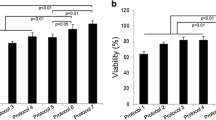Abstract
Experimentation with most human cell types is restricted to the use of cell lines, and this limits our ability to extrapolate interpretations to the in vivo condition. However, in studying human trophoblast cells, we have a unique opportunity to obtain large quantities of readily available human tissue. In this chapter, we outline the methodology for purification of human trophoblast cells from term placentas. The procedures are based on enzymatic dissociation of villous placental tissue, followed by gradient centrifugation and immunomagnetic bead purification. Purity may be assessed by immunocytochemistry or flow cytometry using a number of markers to identify both cytotrophoblast cells and cellular contaminants. The resulting cytotrophoblast cell populations have excellent viability and purity, and may be subjected to long-term culture.
Access this chapter
Tax calculation will be finalised at checkout
Purchases are for personal use only
Similar content being viewed by others
References
Benirschke, K. and Kaufmann, P. (2000) Pathology of the Human Placenta. Springer-Verlag, New York: pp. 55–56.
Morrish, D. W., Dakour, J., Li, H., et al. (1997) In vitro cultured human term cytotrophoblast: a model for normal primary epithelial cells demonstrating a spontaneous differentiation program that requires EGF for extensive development of syncytium. Placenta 18, 577–585.
Kamat, A., Alcorn, J. L., Kunczt, C., and Mendelson, C. R. (1998) Characterization of the regulatory regions of the human aromatase (P450arom) gene involved in placenta-specific expression. Mol. Endocrinol. 12, 1764–1777.
Petroff, M. G., Chen, L., Phillips, T. A., Azzola, D., Sedlmayr, P., and Hunt, J. S. (2003) B7 family molecules are favorably positioned at the human maternal-fetal interface. Biol. Reprod. 68, 1496–1504.
Morales, P. J., Pace, J. L., Platt, J. S., et al. (2003) Placental cell expression of HLA-G2 isoforms is limited to the invasive trophoblast phenotype. J. Immunol. 171, 6215–6224.
Huppertz, B., Frank, H. G., Reister, F., Kingdom, J., Korr, H., and Kaufmann, P. (1999) Apoptosis cascade progresses during turnover of human trophoblast: analysis of villous cytotrophoblast and syncytial fragments in vitro. Lab. Invest. 79, 1687–1702.
Ka, H. and Hunt, J. S. (2003) Temporal and spatial patterns of expression of inhibitors of apoptosis in human placentas. Am. J. Pathol. 163, 413–422.
Abbasi, M., Kowalewska-Grochowska, K., Bahar, M. A., Kilani, R.T., Winkler-Lowen, B., and Guilbert, L. J. (2003) Infection of placental trophoblast by Toxoplasma gondii. J. Infect. Dis. 188, 608–616.
Li, H., Dakour J., Kaufman S., Guilbert, L. J., Winkler-Lowen, B., and Morrish, D.W. (2003) Adrenomedullin is decreased in preeclampsia because of failed response to epidermal growth factor and impaired syncytialization. Hypertension 42, 895–900.
Kliman, H. J., Nestler, J. E., Sermasi, E., Sanger, J. M., and Strauss, J. F. (1986) Purification, characterization, and in vitro differentiation of cytotrophoblasts from human term placentae. Endocrinology 118, 1567–1582.
Douglas, G. C., and King, B. F. (1989) Isolation of pure villous cytotrophoblast from term human placenta using immunomagnetic microspheres. J. Immunol. Methods 119, 259–268.
Guilbert, L. J., Winkler-Lowen, B., Sherburne, R., Rote, N. S., Li, H., and Morrish, D. W. (2002) Preparation and functional characterization of villous cytotrophoblasts free of syncytial fragments. Placenta 23, 175–183.
Potgens, A. J., Kataoka, H., Ferstl, S., Frank, H. G., and Kaufmann, P. (2003) A positive immunoselection method to isolate villous cytotrophoblast cells from first trimester and term placenta to high purity. Placenta 24, 412–423.
Morrish, D. W., Shaw, A. R., Seehafer. J., Bhardwaj, D., and Paras, M. T. (1991) Preparation of fibroblast-free cytotrophoblast cultures utilizing differential expression of the CD9 antigen. In Vitro Cell. Dev. Biol. 27A, 303–306.
Yui, J., Garcia-Lloret, M., Brown, A. J., et al. (1994) Functional-long-term cultures of human term trophoblasts purified by column-elimination of CD9 expressing cells. Placenta 15, 231–246.
Nagamatsu, T., Fuji, T., Ishikawa, T., et al. (2004) A primary cell culture system for human cytotrophoblasts of proximal cytotrophoblast cell columns enabling in vitro acquisition of the extra-villous phenotype. Placenta 25, 153–165.
Brodsky, F. M., Bodmer, W. F., and Parham, P. (1979) Characterization of a monoclonal anti-beta 2-microglobulin antibody and its use in the genetic and biochemical analysis of major histocompatibility antigens. Eur. J. Immunol. 7, 536–545.
Ladasky, J. J., Shum, B. P., Canavez, F., Seuanez, H. N., and Parham, P. (1999) Residue 3 of beta 2-microglobulin affects binding of class I MHC molecules by the W6/32 antibody. Immunogenetics 49, 312–320.
Potgens, A. J., Gaus, G., Frank, H. G., and Kaufmann, P. (2001) Characterization of trophoblast cell isolations by a modified flow cytometry assay. Placenta 22, 251–255.
Ka, H. and Hunt, J. S. (2003) Temporal and spatial patterns of expression of inhibitors of apoptosis in human placentas. Am. J. Pathol. 163, 413–422.
Author information
Authors and Affiliations
Editor information
Editors and Affiliations
Rights and permissions
Copyright information
© 2006 Humana Press Inc.
About this protocol
Cite this protocol
Petroff, M.G., Phillips, T.A., Ka, H., Pace, J.L., Hunt, J.S. (2006). Isolation and Culture of Term Human Trophoblast Cells. In: Soares, M.J., Hunt, J.S. (eds) Placenta and Trophoblast. Methods in Molecular Medicine™, vol 121. Humana Press. https://doi.org/10.1385/1-59259-983-4:201
Download citation
DOI: https://doi.org/10.1385/1-59259-983-4:201
Publisher Name: Humana Press
Print ISBN: 978-1-58829-404-3
Online ISBN: 978-1-59259-983-7
eBook Packages: Springer Protocols




